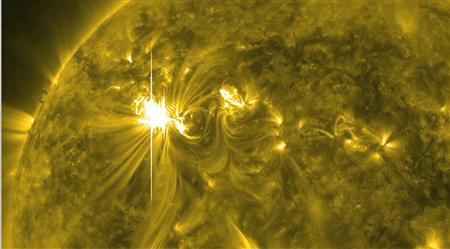
A solar storm that shook the Earth's magnetic field on Thursday spared satellite and power systems as it delivered a glancing blow, although it could still intensify until early Friday, space weather experts said.
 |
| The sun erupts with one of the largest solar flares of this solar cycle in this NASA handout photo taken on March 6, 2012 |
A solar storm that shook the Earth's magnetic field on Thursday spared satellite and power systems as it delivered a glancing blow, although it could still intensify until early Friday, space weather experts said.
The geomagnetic storm surging from the sun was initially expected to be strong enough to disrupt power grids, airplane traffic and space-based satellite navigation systems. But government scientists on Thursday downgraded their prediction on the intensity of the storm - a big cloud of charged particles spawned by two solar flares.
"At this point, it has been oriented in such a way that the net effect on the earth's magnetic field has been minimized," said Joseph Kunches, a space weather specialist at the U.S. National Oceanic and Atmospheric Administration (NOAA).
Kunches said there were still some communication disruptions in the polar regions of the Earth that led airlines to reroute flights on Wednesday to avoid problems. The storm was not likely to be strong enough to disrupt GPS systems, he added.
Like hurricanes, solar storms have a rating system, with G1 being less severe and G5 being more intense. Scientists initially expected a G3 storm, but on Thursday said it turned out to be a "minor" G1 disturbance.
"Now we're just watching for how this is all going to shake out," Kunches said, likening the storm to a passing freight train.
More solar disruptions are still a possibility. The part of the sun that spawned the flares has been pretty quiet in the last 24 hours, but that could change, Kunches said.
"Forecasters are still suspicious that (the Sun) could produce some more eruptive activity," he said.
One thing the storm could still produce is some spectacular auroras, Kunches said.
In the Northern Hemisphere, the aurora borealis could be visible at higher latitudes, such as the northern United States, although the March full moon may make them difficult to see.
(Source: Reuters)




